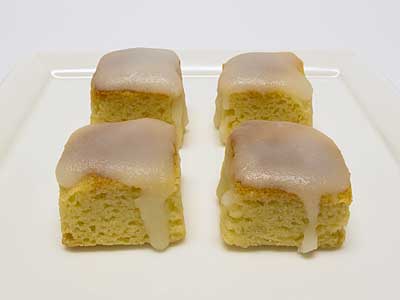October 31, 2011
Mignardise

pyramides de breton
(pyramid-shaped cookies)
In the early autumn of 2000, my wife and I took a little trip, driving through the Loire Valley, Brittany, and Normandy. I had planned the trip so we would stay in hotels in cities located about 2 hours apart. We would spend a few days at each one while we saw the local sights. While driving between the cities, we’d visit points-of-interest along the way or requiring a short detour. We hit as many high (and low) points along the way as time and energy allowed. Having an espresso or glass of wine in a small café always had priority over the major sights.
Our longest drive was from the Loire-Valley city of Angers to the Breton village of Pont-Aven. Angers had provided many wonderful memories including the surprising Musée de l’Ardoise, a museum all about slate, and a hotel room in an old house with a bathroom my wife still talks about. Along the drive to Pont-Aven, we only stopped in Vannes; Nantes and Guérande would be visited a year later. The weather was a bit overcast and drizzly by the time we reached Pont-Aven in the late afternoon. We were staying in a four-room hotel that was part of the Michelin one-star restaurant Le Moulin de Rosmadec. I had chosen the town partly because of the many glowing reports I had read in guide books and partly to eat at this restaurant. I was soon to learn that I would be disappointed on both accounts.
Only one of the fourteen original mills in the town remained in working condition, and it couldn’t be toured. No longer a mill town, starting with Gauguin and continuing until today, Pont-Aven had become a bit of an artist’s colony. There were lots of galleries, most full of seascapes. There were buses of tourists, most of the Asian variety. And there were lots of butter cookies, galettes de Pont-Aven, being sold. (Having not noticed before, we found these same cookies in many local stores when we returned home.) The whole place had a Mendocino-like feel to it.
The meal that night was a bit disappointing. The dining room was rustic and heavy. We were located off the main room in a little alcove and only minimal service was afforded us. The meal also felt rustic and heavy. Both my wife’s lobster and my mixed grill of lamb were a bit overcooked. Unfortunately, my wife’s notes of the evening don’t state whether the mignardise plate included galettes de Pont-Aven.
So when Eddy Van Damme posted an article on his blog referring to sablé breton, my first thoughts went to galettes de Pont-Aven, even though there is nothing similar between the two cookies. Van Damme translates sablé breton as Breton shortbread, which I have a problem with. Sable means “sand” or “sandy” in French, and sablé is a shortbread cookie, at least according to my Collins Dictionary. But in practice, sablés are crumbly cookies and quite different than the Scottish shortbread most people associate with the term. Technically, they may be shortbread cookies, but not what most people think of as shortbread. Plus Van Damme’s cookie dough is a batter that can be piped. It’s not as crumbly as the shortbread dough I’ve worked with in the past, and the finished product is more cake than cookie in texture. In the end, I decided that I would have to give these cookies a different name since they are much different than the sablés I’ve had in the past. Thus the meaningless name, pyramides de breton, was born.
This mignardise consists of three parts: the cookie, the filling, and the icing. The basic cookie recipe is similar to what Van Damme presented in his blog. The icing recipe is an amalgamation of several that I found online. This recipe will produce 18 to 24 cookies.
cookie:
60 g (4+ T)
very soft unsalted butter
45 g (3-2⁄3 T)
finely granulated sugar
1⁄4 t
fine salt
1⁄2 t
vanilla extract
1
large egg yolk
50 g (1⁄3 c)
all-purpose flour
25 g (3-1⁄3 T)
cake flour
5 g (1 t)
baking powder
filling:
smooth jam, any flavor
icing:
50 g (1⁄4 c)
granulated sugar
30 ml (2 T)
water
1 T
powdered sugar
1. Preheat oven to 190 °C (375 °F). Select a silicone mold with 2.5-cm (1-in) square cavities and hollow tops, and place on a rimmed baking sheet.
2. Cream the butter, sugar, salt, and vanilla extract together. When smooth, mix in the egg yolk.
3. Sprinkle the two flours and the baking powder over the butter mixture, and mix until just combined.
4. Place the batter in a pastry bag. Pipe the batter into the mold, filling the cavities not quite full.
5. Bake until golden.
6. Cool on a rack.
7. When cool, fill the cavities in the tops of the cookies with the jam and level the tops with a small spatula. Arrange the filled cookies on an icing rack.
8. Place the sugar and water for the icing in a small saucepan and place over high heat. Bring the sugar to 110 °C (230 °F), and remove the saucepan from the heat. Stir in the powdered sugar.
9. Drizzle the icing over the filled cookies in an attractive manner. Leave the cookies alone until the icing hardens.
© 2011 Peter Hertzmann. All rights reserved.
